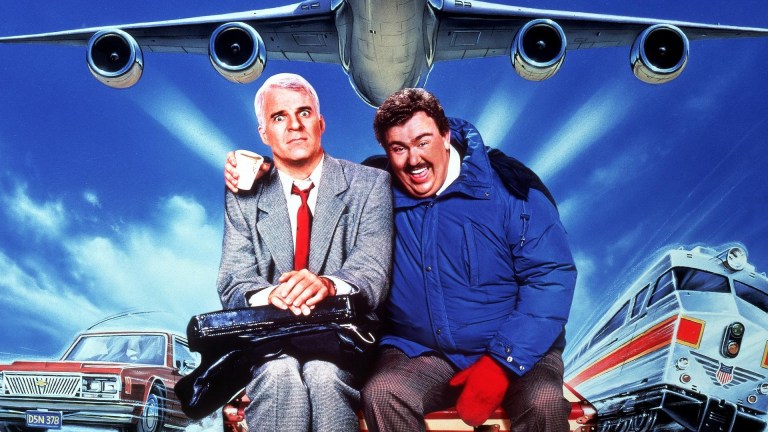5 Reasons Planes, Trains and Automobiles Is the Best Holiday Movie Ever
Planes, Trains and Automobiles has endured for decades as a holiday classic. These are the reasons it works so well.

Hollywood has traditionally overlooked Thanksgiving in favor of literally any other holiday. Christmas has thousands of movies, Halloween has hundreds, and Thanksgiving has about two (all numbers rough estimates). Which is a pity! The best Thanksgiving movie, Planes, Trains, and Automobiles, is also the best holiday movie. It is a lean, 90-minute film about two men yearning for home. Unconstrained by the tinselly pomp that is de rigueur for the holiday genre, Planes, Trains, and Automobiles is at turns side-splittingly funny and throat-tighteningly sad. It’s a masterpiece.
If you’re not already familiar with the film, it stars Steve Martin as Neal Page, an advertising executive trying to get home for Thanksgiving. He encounters Del Griffith (John Candy) early in his journey, and the men end up traveling companions, by circumstance and eventually by necessity. The film is about how the concept of ‘home’ takes on an almost mythical allure at the holidays, along with our driving need to get there, however we can. It is a poignant reminder, too, of those without a place to call home.
Here are the reasons it remains a holiday classic…
1. The Portrayal of Holiday Travel Pain
The film goes to hilarious lengths to embellish just how painful traveling during the holidays can be. The worst most of us have to deal with are flight delays, the occasional cancelation, and increased traffic on the road. Inclement weather often makes things worse—tis the season—but when was the last time you hitchhiked in the back of a refrigerated semi?
Planes, Trains, and Automobiles exaggerates the ordeal in service of laughs, but it’s only funny because we recognize the kernel of truth: holiday travel sucks. It’s the single worst part of the deal. Which is why we silently nod when Neal finally breaks and goes on his f-bomb laced diatribe.
And then there’s the awkward sleeping arrangements when you arrive at your destination. No matter how much it costs, a mattress you inflate like a pool raft is not meant for adults. Still, it’s better than sharing a twin with a sweaty stranger and waking up to him spooning you and your pillows.
2. The Amazing One-Liners
Strictly speaking, being funny doesn’t make a movie more of a holiday film. But great movies need something other than the occasion itself to put them over the top. Planes, Trains, and Automobiles would work as straight drama, but the comedic elements elevate the stakes while also acting as palate cleansers. We also naturally like people who make us laugh. Without the jokes, Neal would just be an up-tight jerk. Even with them, Del can be pretty annoying. The situational comedy helps us empathize with these forlorn travelers. But the things Neal and Del say and do make us love them.
We silently cheer when Del gets comfortable enough with Neal to rib him good-naturedly while the men are driving to Chicago. “You play with your balls a lot. Larry Bird doesn’t do as much ball-handling in one night as you do in one hour.” Hilarious and also a sneaky bit of character-building (next time you watch the film, see if you can spot Neal playing pocket pool). But the single best line of the film belongs to Neal, who delivers this all-timer after being stranded in a rental car lot. “If I wanted a joke, I’d follow you into the john and watch you take a leak.”
3. The Nostalgia for Home at the Holidays
Yes, holiday travel sucks. But there’s a reason we willingly subject ourselves to it. It’s the wistful nostalgia Perry Como sings of in “(There’s No Place Like) Home for the Holidays.” Suddenly and practically all at once, we would do almost anything to be home again, surrounded by our loved ones, and maybe eating some homemade pumpkin pie.
More than any other holiday film, Planes, Trains, and Automobiles is about nostalgia for home, and how home seems so much sweeter the further away we are. Neal only endures all the travel shenanigans because he’s so desperate to reach the smiling faces at the end of this meandering yellow brick road.
But poor Del doesn’t have a home. His nostalgia is for a place that no longer exists. He spends his holidays in transit, entirely alone, because he has no other options. The road is his home now, and it is a cold and lonely one. Just as Del helps Neal become a better version of himself, Neal gives Del the thing he has been missing: a place to go for the holidays.
4. Neal’s Character Growth
All great stories are about an internal journey as well as an external one. The external journey is the plot, the internal represents the character’s growth. Done well, the two influence and reinforce the other. Luke Skywalker rescues Princess Leia (external) and gradually trusts in the Force (internal). That’s a bit simplistic, but you get the gist.
The film is about Neal getting home for Thanksgiving. That’s it. He undergoes a series of increasingly unfortunate events but eventually reaches Chicago. But that’s not really what the movie is about. Neal eventually comes to see Del as something other than an impediment. It’s why their farewell in Chicago takes so long—he doesn’t want to say good-bye. And it’s why Neal turns around and goes back for Del. No longer focused completely on himself, he’s able to piece together the truth about Del.
Most holiday movies are entirely about the external: parties, presents, family squabbles. The timeless ones, the ones that impart meaning to our own holiday traditions, are about people who change magnificently for the better.
5. John Candy
John Candy has been in some great films, but Planes, Trains, and Automobiles is his finest work. Del should be insufferably annoying, but he’s not, and that’s thanks entirely to Candy’s portrayal. He injects Del with a wounded heart that clearly seeps through even when he’s joking and smiling.
We first get a sense of Del’s inner wound when he and Neal get into an argument while sharing a hotel room the first time. Neal pulls no punches in describing just how boring a conversationalist Del is. As the scene goes on, Del’s anger deflates until the only thing left is naked hurt. It is a crushing moment and perhaps the best two-minutes of acting John has ever done, and he doesn’t even say a word.
There is no question that Neal is the “hero” of the story. He’s the one that undertakes the metaphysical journey and emerges a changed man. But John Candy elevates the entire film, making it a classic, and the best holiday movie ever.
